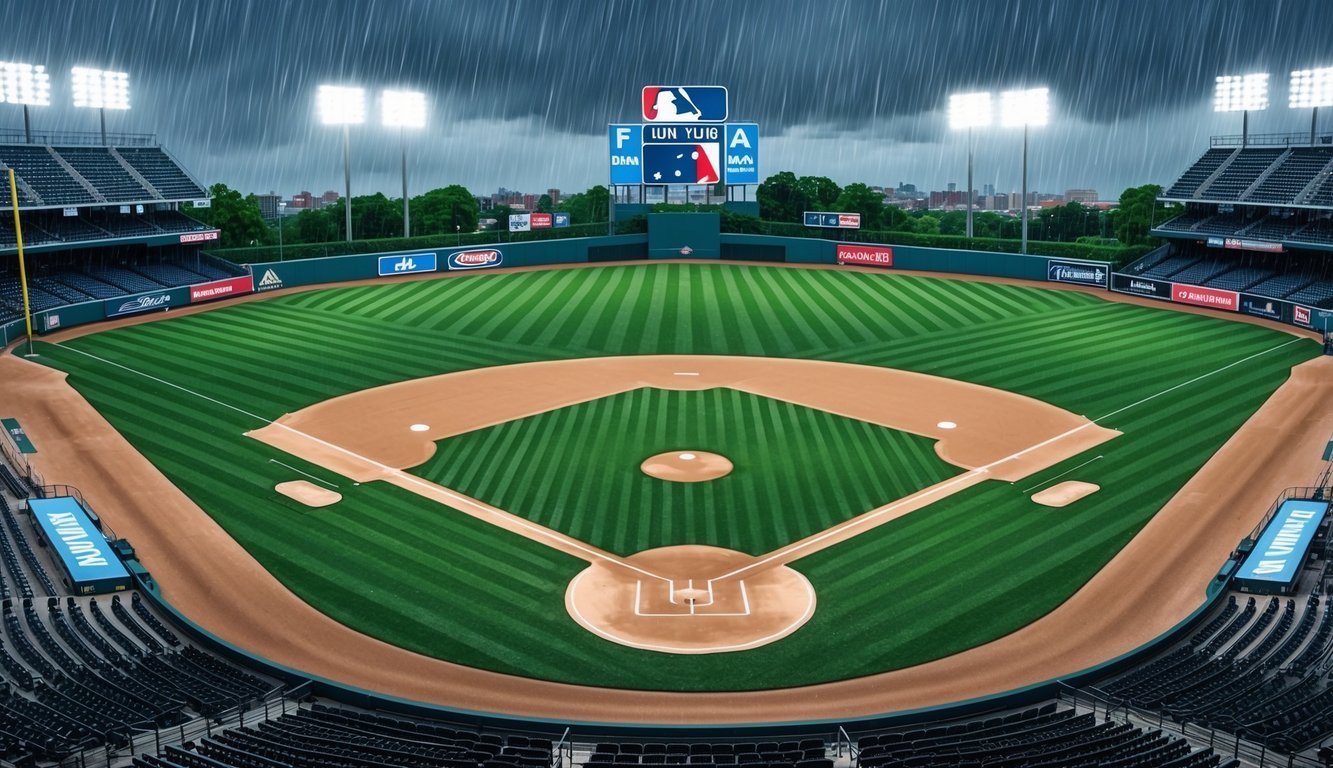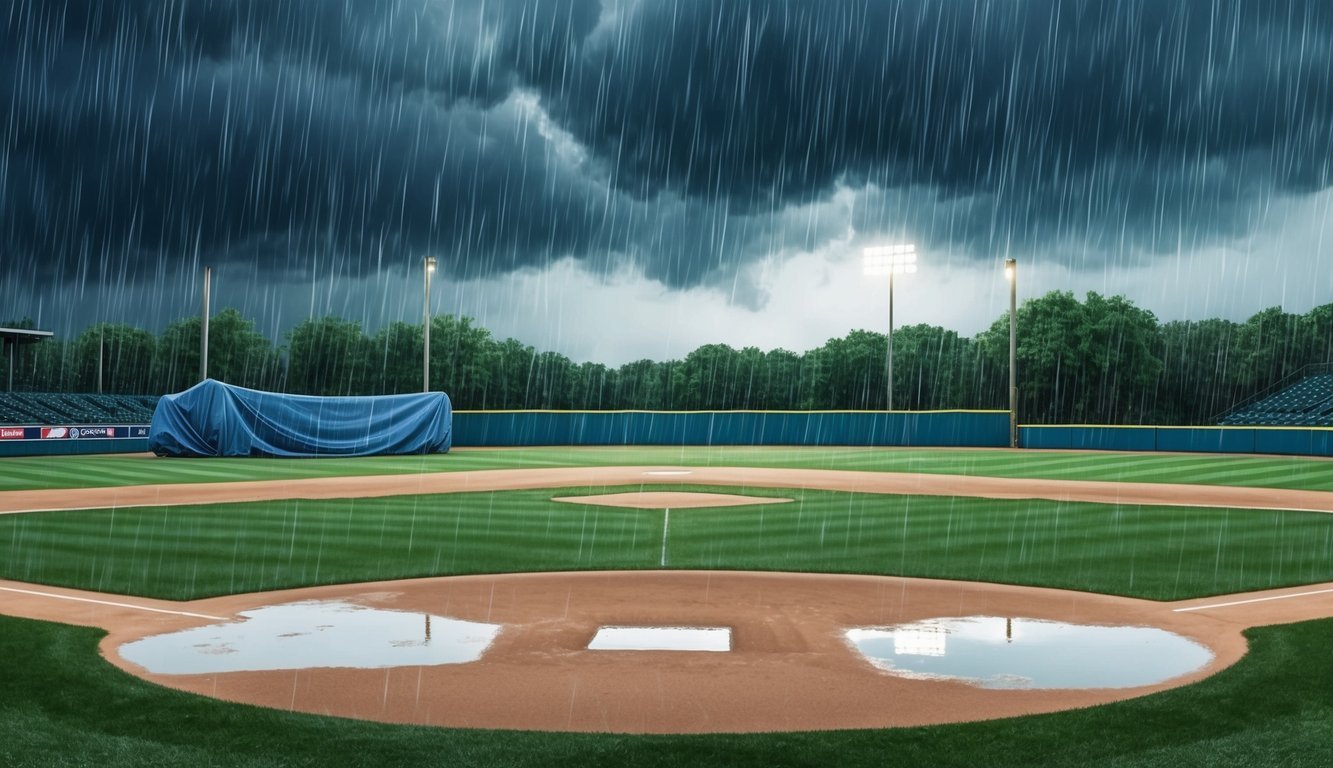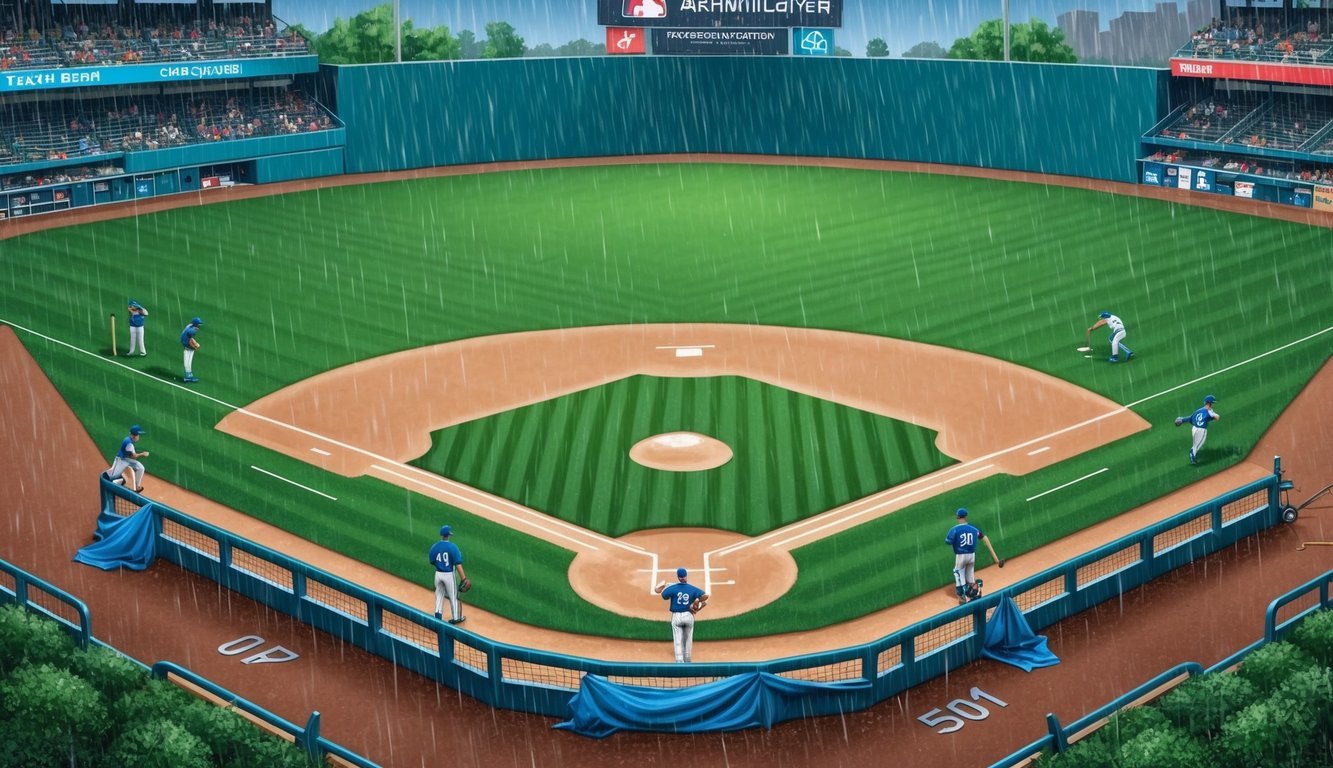Baseball fans know the disappointment of settling in for a game only to see dark clouds roll in.
Rain delays are an unpredictable but inevitable part of Major League Baseball.
While they can disrupt the flow of a game, these pauses also create unique moments and memories for players and spectators alike.
MLB’s current rain delay policy gives umpires 30 minutes to decide whether to postpone or continue a game affected by inclement weather. This standardized approach aims to balance player safety, field conditions, and fan experience.
During delays, teams may retreat to their clubhouses while fans seek shelter in concourses or covered areas.
Rain delays can lead to strategic shifts as managers reassess pitching decisions or lineups.
For fans, they offer a chance to explore the stadium, chat with fellow attendees, or engage in impromptu entertainment.
While delays may test patience, they’re woven into the fabric of baseball lore, sometimes setting the stage for dramatic comebacks or historic performances once play resumes.
Understanding Rain Delays in MLB
Rain delays are a common occurrence in Major League Baseball, impacting game play and schedules.
These interruptions require careful management by officials to ensure player safety and maintain fair competition.
Defining Rain Delay and Its Impact on Play
A rain delay occurs when inclement weather temporarily halts a baseball game.
This pause in play can last anywhere from a few minutes to several hours.
Rain, lightning, fog, and even snow can trigger delays.
These interruptions disrupt the flow of the game and can affect player performance.
Pitchers may struggle to maintain their rhythm after a delay.
Batters might lose their focus.
Teams must adapt their strategies, often reconsidering pitching rotations or lineup changes.
Fans experience disappointment as they wait for play to resume.
In extreme cases, games may be postponed or rescheduled entirely.
This creates logistical challenges for teams and fans alike.
Rain Delay Rules Overview
MLB has established specific rules to handle rain delays fairly and consistently.
These guidelines help determine when to pause play and how to proceed once weather improves.
A game becomes official after the completion of five innings (or four and a half if the home team is ahead).
If rain forces a stoppage before this point, the game is not considered complete and must be replayed from the start.
For games that have reached official status, the score reverts to the last completed inning if play cannot continue.
In tied games, play resumes from the point of interruption at a later date.
Postseason games have stricter rules.
These crucial matchups must be played to completion, regardless of how many innings have been completed when rain strikes.
Mechanics of a Rain Delay Decision
Umpires play a crucial role in managing rain delays.
They continuously monitor weather conditions and field playability.
When rain threatens, umpires consult with groundskeepers and team managers to assess the situation.
If a delay is deemed necessary, umpires signal for the grounds crew to cover the field with a tarp.
This protects the playing surface from excessive water damage.
Players retreat to their clubhouses during the delay.
MLB allows for up to a 30-minute pause before deciding to postpone or continue the game.
Umpires review weather forecasts and field conditions throughout this period.
If conditions improve, play resumes.
If not, the game may be suspended or postponed.
Safety is paramount in these decisions.
Wet fields increase injury risk, while lightning poses serious danger.
Umpires must balance competitive fairness with player well-being when making these crucial calls.
Consequences of Game Postponement
When MLB games are postponed due to rain, it triggers a cascade of effects for teams, players, and fans.
The rescheduling process can be complex, impacting everything from team travel plans to player performance.
Rescheduling and Team Logistics
Rainouts often lead to doubleheaders, cramming two games into one day.
This can strain pitching rotations and bullpens.
Teams might need to adjust their travel schedules, sometimes extending road trips or shortening rest periods between series.
The home team typically decides when to reschedule a postponed game.
They must consider factors like shared stadiums, TV contracts, and the visiting team’s schedule.
In some cases, games are moved to neutral sites or played at the end of the season if they affect playoff standings.
Groundskeepers play a crucial role during rainouts.
They rush to cover the field with tarps to prevent mud and keep the playing surface from becoming too slippery.
Their quick actions can make the difference between a delay and a full postponement.
Impact on Players and Game Strategy
Postponed games can disrupt players’ routines and momentum.
A hot hitter might cool off during an unexpected break, while a struggling pitcher could get extra rest.
Managers must reconsider their lineup choices and pitching rotations.
A scheduled starter might be pushed back or used in relief if the team faces a string of games without rest days.
Weather delays can also affect in-game strategy.
If rain is forecasted, teams might play more aggressively early on, knowing the game could be called after five innings and declared official.
Players often develop unique routines to stay loose during rain delays.
Some play cards, while others might engage in impromptu dugout games, earning them playful nicknames from teammates.
Fans’ Perspective on Rain Delays
For fans, rainouts can be frustrating.
Those who traveled to the ballpark might not be able to attend the rescheduled game.
Most teams offer ticket exchanges or refunds for washouts, but fans still lose time and potentially travel expenses.
Rain delays can create memorable moments, though.
Fans might witness tarp slides by grounds crew members or see players interacting with the crowd during long waits.
Some stadiums offer indoor attractions or covered concourses where fans can wait out delays.
Smart spectators often check the weather forecast and bring ponchos to be prepared for potential rain.
Social media has changed how fans experience rain delays.
Teams now use platforms like Twitter to keep attendees updated on start times and postponement decisions, helping fans make informed choices about waiting it out or heading home.
MLB Policies and Technology

MLB has made significant strides in managing rain delays through updated policies and cutting-edge stadium technology.
These advancements aim to enhance the fan experience and minimize disruptions to games.
Rainout Policies and Tickets
MLB’s rainout policy prioritizes fan satisfaction and fair play.
If a game is postponed due to weather, tickets are typically valid for the rescheduled date.
Some teams offer exchanges or refunds for those unable to attend the makeup game.
The league empowers the umpire-in-chief or crew chief to make decisions about game delays or postponements.
They consider factors like field conditions, weather forecasts, and player safety.
These decisions have been a crucial part of the game since the early days of national league formation, ensuring fairness and consistency.
Umpires rely on input from groundskeepers and team managers to assess whether play can continue safely.
By prioritizing these factors, they help maintain the integrity of the game while safeguarding players and fans alike.
MLB rules now allow for a 30-minute delay before deciding to postpone or continue a game.
This gives teams and officials time to assess the situation and make informed choices.
Advancements in Stadium Technology
Many MLB stadiums now feature retractable roofs, revolutionizing how teams handle inclement weather.
These roofs can close in minutes, allowing games to continue despite rain or other adverse conditions.
Retractable roofs offer flexibility, letting teams play in open-air conditions when weather permits while providing protection when needed.
This technology has significantly reduced rainouts and delays in equipped stadiums.
Advanced weather monitoring systems help teams and officials make proactive decisions about potential delays or postponements.
These tools provide real-time data on precipitation, wind speeds, and lightning strikes.
Some stadiums have installed state-of-the-art drainage systems to quickly remove water from the field, minimizing delay times after rainfall stops.
Historical Rain Delays and Records

Rain delays have left an indelible mark on Major League Baseball, creating unforgettable moments and testing the patience of players and fans alike.
These weather-related interruptions have led to some of the most unusual and drawn-out games in the sport’s history.
Memorable Rain Delay Moments
The 2013 season saw a remarkable rain delay during a doubleheader between the San Francisco Giants and Cincinnati Reds.
The Giants found themselves in the unusual position of playing as the home team in Cincinnati due to a rainout earlier in the season.
Mother Nature wasn’t done yet, as rain caused another lengthy delay during this rescheduled game.
Opening Day ceremonies have also fallen victim to rain delays.
In 2018, the Washington Nationals and Cincinnati Reds endured a long wait before their season opener could begin.
Players kept spirits high by entertaining fans with impromptu dance routines and playful antics in the dugout.
Record-Breaking Delays in MLB
The longest rain delay in MLB history occurred on August 12, 1990, during a game between the Chicago White Sox and Texas Rangers.
The delay lasted a staggering 7 hours and 23 minutes before officials finally called the game.
Fans who stuck around were treated to impromptu entertainment by groundskeepers and mascots.
Another notable delay happened on May 5, 2019, when the Boston Red Sox and Tampa Bay Rays endured a 3-hour, 36-minute rain delay.
The game, which started at 1:05 PM, didn’t finish until 10:40 PM, making it one of the longest nine-inning games in MLB history.
The New York Yankees and Cleveland Guardians experienced a significant delay in 2022.
A sudden downpour halted play for 2 hours and 17 minutes, testing the endurance of players and spectators alike.
Managing Delays and Resuming Play

MLB teams and officials have established protocols to handle rain delays efficiently.
These procedures prioritize player safety while aiming to complete games when possible.
Preparations for Resuming the Game
When rain stops, groundskeepers spring into action.
They remove the tarp and work to dry the field.
Players warm up and stretch to stay loose.
Umpires inspect the playing surface to ensure it’s safe.
The grounds crew may use quick-dry materials to absorb excess moisture.
They focus on key areas like the pitcher’s mound and batter’s box.
Leaf blowers help dry grass and dirt faster.
Teams often use the delay time strategically.
Managers might switch pitchers or adjust lineups.
Players review opponent strategies or watch game footage.
Communication and Safety Considerations
During delays, umpires consult with team managers and MLB officials.
They also review weather forecasts and field conditions.
Fan safety is a top priority.
Stadium staff guide spectators to sheltered areas if severe weather threatens.
Teams use social media and PA systems to keep fans informed.
If conditions don’t improve after 30 minutes, umpires may call the game.
In the playoffs, officials make every effort to complete games.
They might wait hours for weather to clear.
The score at the time of delay can impact decisions.
If five innings are complete, it’s an official game.
The leading team can be declared the winner if play can’t resume.
